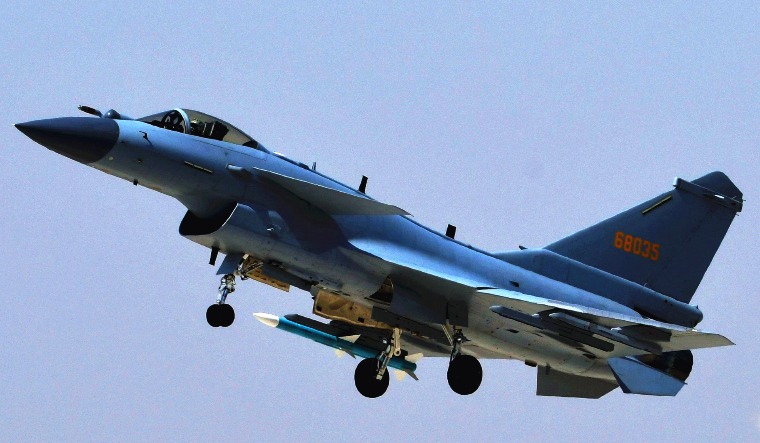In December 2006, China announced it had inducted a new single-engine fighter designated the J-10. Over the years, the J-10 has become, arguably, the most important fighter in the People's Liberation Army Air Force, in terms of numbers.
According to an estimate published by Japan's defence ministry in March this year, China operates 468 J-10 fighters.
The J-10 is a multi-role fighter that belongs to the same weight category as the ubiquitous US F-16.
The existence of the J-10 was a source of much curiosity before its official unveiling, in part due to the aircraft's uncanny similarity to the Israeli 'Lavi' fighter, a project that was cancelled in the late 1980s.
And even before China unveiled the J-10 to the world, there was speculation Pakistan was interested in purchasing it. In April 2006, the UK's Financial Times reported that Western diplomats believed Pakistan was seeking “35-40” J-10 fighters in a deal worth at least $1.5 billion. Ever since then, the speculation about Pakistan's interest in buying the J-10 has continued, with occasional news reports and passionate debate and rumours on social media.
While Pakistan has yet to announce a deal for the J-10, a senator in the country has already opposed buying the platform.
Senator Dr. Afnan Ullah Khan, a member of the opposition Pakistan Muslim League-Nawaz (PML-N), on Friday tweeted he did not “understand the logic behind buying J-10C”. The J-10C is the newest variant of the J-10 and entered service with the PLAAF in 2018.
Afnan Ullah Khan wrote Pakistan already had a fighter in a “similar” class as the J-10, referring to the F-16, which the Pakistan Air Force inducted into service in the early 1980s. He also argued that the J-10C was not “as good as the Rafale”, which is in service with the Indian Air Force. Afnan Ullah Khan called for investing funds, purportedly meant to buy the J-10, in the JF-17 fighter programme and Project Azm, Pakistan's initiative to develop a fifth-generation stealth fighter and other advanced systems such as long-endurance drones.
The senator wrote, “I don’t understand the logic behind buying J-10C. We already have a fighter (F-16) which is in the similar class and generation. I don’t think J-10C is as good as Rafale also. We should have invested this money in building Project Azm and enhancing JF-17 capabilities.”
It is yet unclear what led to the tweet by the senator. Last week, a handful of Pakistani media outlets, such as The Nation, published brief reports that the J-10C would be part of the Pakistan Air Force next year.
Why Pakistan may want the J-10
The J-10 is estimated to have a maximum take-off weight of 18-20 tonnes and can carry a maximum payload of around 6.5 tonnes, including air-to-air missiles and various air-to-ground munitions.
While a layperson may think the J-10 appears similar in layout to the F-16, the Chinese aircraft has a delta wing design with 'canards' forward of the fuselage. Canards are small wing-like control surfaces that improve the aircraft's agility by reducing drag. The delta-canard design was a major trend of aircraft design in the 1980s, with multiple fighters—such as the Eurofighter Typhoon, Rafale, Saab Gripen and Israeli Lavi—adopting it. There has been suspicion Israel transferred technology for the Lavi fighter to China, though both Beijing and Tel Aviv have dismissed the claims.
Due to the delta-canard design and heavier take-off weight, the J-10 can carry a heavier payload of weapons and is more agile than the JF-17 fighter, which is the Pakistan Air Force's main fighter in terms of numbers. Pakistan has inducted over 100 JF-17 fighters, which were designed in China, but are jointly manufactured by the two nations. The PLAAF has not inducted the JF-17 into service.
Ever since the Indian Air Force announced its decision to buy the Rafale in 2012, Pakistani analysts have argued for buying the J-10 or China's J-31 stealth fighter to counter India.
also read
- Pakistan maintains only 5 killed in attack on military convoy; BLA releases suicide bombing video
- BLA attack video: 90 Pakistani troops killed in suicide blast targeting military convoy of 8 buses, say reports
- These 41 countries at risk of Trump's travel ban | Hint: India's 4 neighbours among them
- MEA reacts to Pakistan's 'India involved in terrorism' statement: 'Look inwards'
The J-10C features improvements over earlier J-10 variants. Most notable among the improvements is an active electronically scanned array radar (AESA), which can scan in multiple directions simultaneously, allowing greater situational awareness. Moreover, the J-10C is believed to be capable of firing the PL-15 air-to-air missile. The PL-15 is considered a very-long-range air-to-air missile, which can engage targets around 200km away. Analysts believe the PL-15 can destroy force multipliers such as aerial refuellers and airborne early warning systems.
Pakistan’s adverse financial situation and tenuous ties with the West in recent years have meant that China remains the only realistic source of advanced fighter jets for the PAF.
Why J-10 may be a bad deal
While the J-10 is China's most advanced indigenous fighter available for export, it has yet to win any international customers. Early variants of the J-10 were equipped with the Russian-built AL-31 engine, the same power plant used in the Su-27 and Su-30 fighters. This would potentially have caused complications when the J-10 was competing with Russian aircraft for orders.
The J-10C is powered by an indigenous Chinese engine, which would make the aircraft 'independent' of Russian export clearances. However, it is yet unclear how durable the Chinese-built engines are as previous indigenous power plants have had short service lifespans.
Given Pakistan’s financial woes, the possibility of Islamabad being able to both fund purchase of the J-10 and develop a fifth-generation fighter currently appears bleak.












